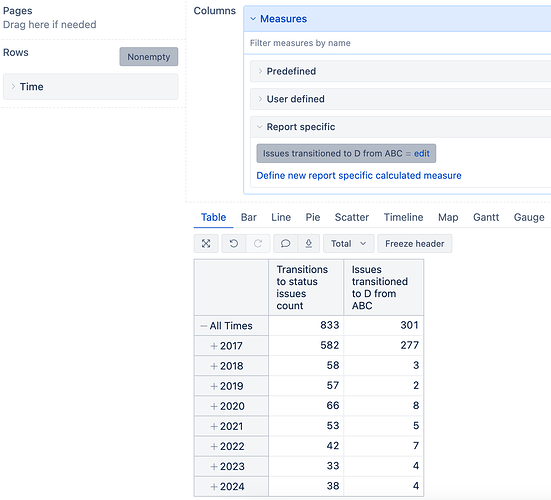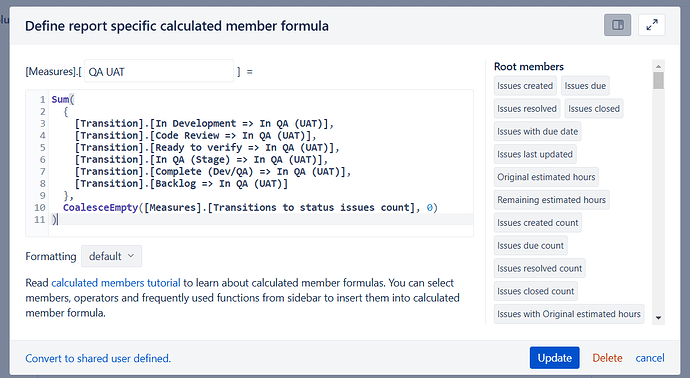Hi @martins.vanags
Here’s the export of my report :-
{
“cube_name”: “Issues”,
“cube_reports”: [ {
“name”: “QA Transition Metrics”,
“folder_name”: “AutoEntry By Sage - QA”,
“result_view”: “bar_chart”,
“definition”: {“columns”:{“dimensions”:[{“name”:“Measures”,“selected_set”:[“[Measures].[QA Stage]”,“[Measures].[Code Review]”,“[Measures].[In Development(Staging)]”,“[Measures].[Unclear(Staging)]”,“[Measures].[QA UAT]”,“[Measures].[Ready to deploy]”,“[Measures].[In Development(UAT)]”,“[Measures].[Unclear(UAT)]”],“members”:}]},“rows”:{“dimensions”:[{“name”:“Time”,“selected_set”:[“[Time].[Today]”],“members”:,“bookmarked_members”:}]},“pages”:{“dimensions”:[{“name”:“Label”,“selected_set”:[“[Label].[All Teams]”,“[Label].[Prometheus(AE)]”,“[Label].[Atlas(AE)]”,“[Label].[Kronos(AE)]”,“[Label].[Cosmos(AE)]”,“[Label].[Customer Support(AE)]”],“members”:[{“depth”:0,“name”:“All Teams”,“full_name”:“[Label].[All Teams]”,“calculated”:true,“drillable”:true,“dimension”:“Label”}],“bookmarked_members”:,“current_page_members”:[“[Label].[All Teams]”]},{“name”:“Time”,“duplicate”:true,“selected_set”:[“[Time].[Today]”,“[Time].[Yesterday]”,“[Time].[Current month]”,“[Time].[Previous month]”],“members”:[{“depth”:0,“name”:“Today”,“full_name”:“[Time].[Today]”,“calculated”:true,“drillable”:true,“id”:“[Time].[Today]”,“format_string”:“”}],“bookmarked_members”:,“current_page_members”:[“[Time].[Today]”]}]},“options”:{},“view”:{“current”:“bar_chart”,“maximized”:false,“bar_chart”:{“stacked”:false,“vertical”:true,“swap_axes”:true,“data_labels”:true,“series_options”:{}},“table”:{}},“calculated_members”:}
} ],
“calculated_members”: [{“dimension”:“Time”,“name”:“Current month”,“format_string”:“”,“formula”:“Aggregate({\n [Time].[Month].CurrentDateMember\n})”},{“dimension”:“Time”,“name”:“Previous month”,“format_string”:“”,“formula”:“Aggregate({\n [Time].[Month].CurrentDateMember.PrevMember\n})”},{“name”:“Prometheus(AE)”,“dimension”:“Label”,“formula”:“Aggregate(\n Filter(\n [Label].Members,\n [Label].CurrentMember.Name = "backend"\n AND \n NOT ([Label].CurrentMember.Name = "CSBug")\n )\n)”,“format_string”:“”},{“name”:“Atlas(AE)”,“dimension”:“Label”,“formula”:“[Label].[XPE]”,“format_string”:“”},{“name”:“Kronos(AE)”,“dimension”:“Label”,“formula”:“[Label].[SFA]”,“format_string”:“”},{“name”:“Cosmos(AE)”,“dimension”:“Label”,“formula”:“[Label].[productboostteam]”,“format_string”:“”},{“name”:“Customer Support(AE)”,“dimension”:“Label”,“formula”:“Aggregate(\n Filter(\n [Label].Members,\n [Label].CurrentMember.Name = "CSBug"\n AND \n NOT ([Label].CurrentMember.Name = "SFA")\n AND\n NOT ([Label].CurrentMember.Name = "XPE")\n AND\n NOT ([Label].CurrentMember.Name = "productboostteam")\n AND\n NOT ([Label].CurrentMember.Name = "xpe")\n )\n)”,“format_string”:“”},{“name”:“All Teams”,“dimension”:“Label”,“formula”:“Aggregate(\n Filter(\n [Label].Members,\n [Label].CurrentMember.Name = "productboostteam"\n OR \n [Label].CurrentMember.Name = "CSBug"\n OR \n [Label].CurrentMember.Name = "backend"\n OR \n [Label].CurrentMember.Name = "XPE"\n OR \n [Label].CurrentMember.Name = "xpe"\n OR \n [Label].CurrentMember.Name = "sfa"\n )\n)”,“format_string”:“”},{“name”:“Today”,“dimension”:“Time”,“formula”:“Aggregate({\n [Time].[Day].CurrentDateMember\n})”,“format_string”:“”},{“name”:“Yesterday”,“dimension”:“Time”,“formula”:“Aggregate(\n {\n [Time].[Day].CurrentDateMember.PrevMember\n }\n)”,“format_string”:“”},{“name”:“QA Stage”,“dimension”:“Measures”,“formula”:“Sum(\n {\n [Transition].[In Development =\u003e In QA (Stage)],\n [Transition].[Code Review =\u003e In QA (Stage)],\n [Transition].[Ready to verify =\u003e In QA (Stage)],\n [Transition].[In QA (UAT) =\u003e In QA (Stage)],\n [Transition].[Complete (Dev/QA) =\u003e In QA (Stage)],\n [Transition].[Backlog =\u003e In QA (Stage)]\n },\n CoalesceEmpty([Measures].[Transitions to status issues count], 0)\n)”,“format_string”:“”},{“name”:“In Development(Staging)”,“dimension”:“Measures”,“formula”:“Sum(\n {\n [Transition].[In QA (Stage) =\u003e In Development]\n },\n CoalesceEmpty([Measures].[Transitions to status issues count], 0)\n)”,“format_string”:“”},{“name”:“Code Review”,“dimension”:“Measures”,“formula”:“Sum(\n {\n [Transition].[In QA (Stage) =\u003e Ready to verify],\n [Transition].[In QA (Stage) =\u003e Code Review]\n },\n CoalesceEmpty([Measures].[Transitions to status issues count], 0)\n)”,“format_string”:“”},{“name”:“Unclear(Staging)”,“dimension”:“Measures”,“formula”:“Sum(\n {\n [Transition].[In QA (Stage) =\u003e Unclear]\n },\n CoalesceEmpty([Measures].[Transitions to status issues count], 0)\n)”,“format_string”:“”},{“name”:“QA UAT”,“dimension”:“Measures”,“formula”:“Sum(\n {\n [Transition].[In Development =\u003e In QA (UAT)],\n [Transition].[Code Review =\u003e In QA (UAT)],\n [Transition].[Ready to verify =\u003e In QA (UAT)],\n [Transition].[In QA (Stage) =\u003e In QA (UAT)],\n [Transition].[Complete (Dev/QA) =\u003e In QA (UAT)],\n [Transition].[Backlog =\u003e In QA (UAT)]\n },\n CoalesceEmpty([Measures].[Transitions to status issues count], 0)\n)”,“format_string”:“”},{“name”:“In Development(UAT)”,“dimension”:“Measures”,“formula”:“Sum(\n {\n [Transition].[In QA (UAT) =\u003e In Development]\n },\n CoalesceEmpty([Measures].[Transitions to status issues count], 0)\n)”,“format_string”:“”},{“name”:“Ready to deploy”,“dimension”:“Measures”,“formula”:“Sum(\n {\n [Transition].[In QA (Stage) =\u003e Ready to Deploy],\n [Transition].[Code Review =\u003e Ready to Deploy],\n [Transition].[Ready to verify =\u003e Ready to Deploy],\n [Transition].[In QA (UAT) =\u003e Ready to Deploy],\n [Transition].[In QA (Stage) =\u003e Passed UAT],\n [Transition].[Code Review =\u003e Passed UAT],\n [Transition].[Ready to verify =\u003e Passed UAT],\n [Transition].[In QA (UAT) =\u003e Passed UAT]\n },\n CoalesceEmpty([Measures].[Transitions to status issues count], 0)\n)”,“format_string”:“”},{“name”:“Unclear(UAT)”,“dimension”:“Measures”,“formula”:“Sum(\n {\n [Transition].[In QA (UAT) =\u003e Unclear]\n },\n CoalesceEmpty([Measures].[Transitions to status issues count], 0)\n)”,“format_string”:“”}]
}


